Degradation Characteristics and Mechanism of Black Sandy Dolostone Subjected to Wetting–Drying Cycles
Abstract
:1. Introduction
2. Materials and Methods
2.1. Chemical Composition of Sample
2.2. Experiments
2.2.1. Sample Preparation and Immersion
2.2.2. Water Absorption Test
2.2.3. Surface Hardness Test
2.2.4. Uniaxial Compression Test
2.2.5. BET and BJH Test
3. Results
3.1. Effect of Wetting–Drying Cycles on Water Absorption
3.2. Effect of Wetting–Drying Cycles on Surface Hardness
3.3. Unconfined Compressive Strength of Dolostone Subjected to W–D Cycles
4. Discussion
4.1. Effect of Wetting–Drying Cycles on Microstructure
4.2. Effect of Wetting–Drying Cycles on pH and EC of Solution
4.3. Mechanism of Water–Rock Interaction Subjected to Wetting–Drying Cycles
5. Conclusions
- (1)
- The water absorption, surface hardness and uniaxial compressive strength of the rock generally decrease with increasing wetting–drying cycle in the treatment. The relationships between the deterioration degree (water absorption and uniaxial compressive strength) and the number of W–D cycles were obtained from the laboratory experiment.
- (2)
- The average pore size of the dolostone increased, while the specific surface area decreased accordingly after 12 W–D cycles. The results permit water to enter into the pore and react with the rock sufficiently and cause the strength and structure of dolostone deterioration from the micro perspective.
- (3)
- It was found that the pH and EC values increased during the cyclic W–D treatment. Combined with the mineral and water chemistry analysis, it contributed to the feldspar and carbonate minerals dissolution during the water–rock interaction.
Author Contributions
Funding
Data Availability Statement
Acknowledgments
Conflicts of Interest
References
- Trenhaile, A. Tidal wetting and drying on shore platforms: An experimental study of surface expansion and contraction. Geomorphology 2006, 76, 316–331. [Google Scholar] [CrossRef]
- Peng, J.; Rong, G.; Cai, M.; Wang, X.J.; Zhou, C.B. An empirical failure criterion for intact rocks. Rock Mech. Rock. Eng. 2014, 47, 347–356. [Google Scholar] [CrossRef]
- Zhao, S.; Dai, F.; Deng, J.; Wen, H.; Li, H.; Chen, F. Insights into landslide development and susceptibility in extremely complex alpine geoenvironments along the western Sichuan-Tibet Engineering Corridor, China. Catena 2023, 227, 107105. [Google Scholar] [CrossRef]
- Hale, P.D.; Shakoor, A. A laboratory investigation of the effects of cyclic heating and cooling, wetting and drying, and freezing and thawing on the compressive strength of selected sandstones. Environ. Eng. Geosci. 2003, 9, 117–130. [Google Scholar] [CrossRef]
- Hall, K.J.; Hall, A. Weathering by wetting and drying: Some experimental results. Earth Surf. Proc. Land. 1996, 21, 365–376. [Google Scholar] [CrossRef]
- Wells, T.; Binning, P.; Willgoose, G. The role of moisture cycling in the weathering of a quartz chlorite schist in a tropical environment: Findings of a laboratory simulation. Earth Surf. Proc. Land. 2005, 30, 413–428. [Google Scholar] [CrossRef]
- Kanyaya, J.I.; Trenhaile, A.S. Tidal wetting and drying on shore platforms: An experimental assessment. Geomorphology 2005, 70, 129–146. [Google Scholar] [CrossRef]
- Cantón, Y.; Solé-Benet, A.; Queralt, I.; Pini, R. Weathering of a gypsum-calcareous mudstone under semi-arid environments at Tabernas, SE Spain: Laboratory and field-based experimental approaches. Catena 2001, 44, 111–132. [Google Scholar] [CrossRef]
- Gokceoglu, C.; Ulusay, R.; Sonmez, H. Factors affecting the durability of selected weak and clay-bearing rocks from Turkey, with particular emphasis on the influence of the number of drying and wetting cycles. Eng. Geol. 2000, 57, 215–237. [Google Scholar] [CrossRef]
- Torres-Suarez, M.; Alarcon-Guzman, A.; Moya, R. Effects of loading–unloading and wetting–drying cycles on geomechanical behaviors of mudrocks in the Colombian Andes. J. Rock Mech. Geotech. Eng. 2014, 6, 257–268. [Google Scholar] [CrossRef]
- Gratchev, I.; Pathiranagei, S.V.; Kim, D.H. Strength properties of fresh and weathered rocks subjected to wetting-drying cycles. Geomech. Geophy. Geo-Energy Geo-Resour. 2019, 5, 211–221. [Google Scholar] [CrossRef]
- Sumner, P.D.; Loubser, M.J. Experimental sandstone weathering using different wetting and drying moisture amplitudes. Earth Surf. Proc. Land. 2008, 33, 985–990. [Google Scholar] [CrossRef]
- Li, X.; Peng, K.; Peng, J.; Hou, D. Experimental investigation of cyclic wetting-drying effect on mechanical behavior of a medium-grained sandstone. Eng. Geol. 2021, 293, 106335. [Google Scholar] [CrossRef]
- Liao, X.; Chigira, M.; Matsushi, Y.; Wu, X. Investigation of water–rock interactions in Cambrian black shale via a flow-through experiment. Appl. Geochem. 2014, 51, 65–78. [Google Scholar] [CrossRef]
- Thewes, M.; Hollmann, F. Assessment of clay soils and clay-rich rock for clogging of TBMs. Tunn. Undergr. Sp. Technol. 2016, 57, 122–128. [Google Scholar] [CrossRef]
- Fransson, Å.; Viola, G. Bentonite rock interaction experiment: A hydro-structural-mechanical approach. Eng. Geol. 2021, 28, 105985. [Google Scholar] [CrossRef]
- Franzoni, E.; Sassoni, E. Correlation between microstructural characteristics and weight loss of natural stones exposed to simulated acid rain. Sci. Total Environ. 2011, 412, 278–285. [Google Scholar] [CrossRef]
- Li, J.; Kaunda, R.B.; Zhou, K. Experimental investigations on the effects of ambient freeze-thaw cycling on dynamic properties and rock pore structure deterioration of sandstone. Cold Reg. Sci. Technol. 2018, 154, 133–141. [Google Scholar] [CrossRef]
- Park, J.; Choi, B.Y.; Lee, M.; Yang, M. Porosity changes due to analcime in a basaltic tuff from the Janggi Basin, Korea: Experimental and geochemical modeling study of CO2-water-rock interactions. Environ. Earth Sci. 2021, 80, 81. [Google Scholar] [CrossRef]
- Cuisinier, O.; Masrouri, F.; Mehenni, A. Alteration of the Hydromechanical performances of a stabilized compacted soil exposed to successive wetting–drying cycles. J. Mater. Civ. Eng. 2020, 32, 04020349. [Google Scholar] [CrossRef]
- Soltani, A.; Deng, A.; Taheri, A.; Mirzababaei, M.; Vanapalli, S.K. Swell–shrink behavior of rubberized expansive clays during alternate wetting and drying. Miner 2019, 9, 224. [Google Scholar] [CrossRef]
- Estabragh, A.R.; Soltani, A.; Javadi, A.A. Effect of pore water chemistry on the behaviour of a kaolin-bentonite mixture during drying and wetting cycles. Eur. J. Environ. Civ. Eng. 2019, 24, 895–914. [Google Scholar] [CrossRef]
- Kholghifard, M. Effective stress and compressibility of unsaturated clayey soil under drying and wetting cycles. Period. Polytech. Civ. Eng. 2020, 64, 999–1006. [Google Scholar]
- Király, C.; Varga, G.; Falus, G.; Szalai, Z. Effect of water-rock interaction on particle shapes in sandstone samples (Pannonian Basin, Hungary). Geophys. Res. Abstr. 2019, 21, 1. [Google Scholar]
- Medina, F.G.C.; Ventura-Houle, R.; Rodríguez, L.H.; Lara, G.N.R.; Mansilla, O.G.; Ramírez, E.N. Water–rock interactions in a karst aquifer located in southwestern Tamaulipas, Mexico. Carbonates Evaporites 2021, 36, 59. [Google Scholar] [CrossRef]
- Chigira, M.; Oyama, T. Mechanism and effect of chemical weathering of sedimentary rocks. Eng. Geol. 1999, 55, 3–14. [Google Scholar] [CrossRef]
- Helson, O.; Eslami, J.; Beaucour, A.L.; Noumowe, A.; Gotteland, P. Durability of soil mix material subjected to wetting/drying cycles and external sulfate attacks. Constr. Build. Mater. 2018, 192, 416–428. [Google Scholar] [CrossRef]
- Jerman, M.; Scheinherrova, L.; Medve, I.; Krejsová, J.; Černý, R. Effect of cyclic wetting and drying on microstructure, composition and length changes of lime-based plasters. Cem. Concr. Compos. 2019, 104, 103411. [Google Scholar] [CrossRef]
- Guo, J.; Liu, P.; Wu, C.; Wang, K. Effect of dry–wet cycle periods on properties of concrete under sulfate attack. Appl. Sci. 2021, 11, 888. [Google Scholar] [CrossRef]
- Ling, S.; Wu, X.; Zhao, S.; Liao, X. Evolution of porosity and clay mineralogy associated with chemical weathering of black shale: A case study of Lower Cambrian black shale in Chongqing, China. J. Geochem. Explor. 2018, 188, 326–339. [Google Scholar] [CrossRef]
- Ling, S.; Wu, X.; Sun, C.; Liao, X.; Ren, Y. Mineralogy and geochemistry of three weathered Lower Cambrian black shale profiles in Northeast Chongqing, China. Geosci. J. 2016, 20, 793–812. [Google Scholar] [CrossRef]
- Noor-E-Khuda, S.; Albermani, F. Flexural strength of weathered granites under wetting-drying cycles: Implications to steel structures. Adv. Steel Constr. 2019, 15, 225–231. [Google Scholar]
- Tian, H.; Kempka, T.; Yu, S.; Ziegler, M. Mechanical properties of sandstones exposed to high temperature. Rock Mech. Rock. Eng. 2015, 49, 321–327. [Google Scholar] [CrossRef]
- Kovalski, E.R.; Kongar-Syuryun, C.B.; Petrov, D.N. Challenges and prospects for several-stage stoping in potash minining. Sustain. Dev. Mt. Territ. 2023, 15, 349–364. [Google Scholar] [CrossRef]
- Kaung, P.F.; Semikin, A.A.; Khayrutdinov, A.M.; Dekhtyarenko, A.A. Recycling of industrial waste is a paradigm of resource provision for sustainable development. Sustain. Dev. Mt. Territ. 2023, 15, 385–397. [Google Scholar] [CrossRef]
- Bardestani, R.; Patience, G.; Kaliaguine, S. Experimental methods in chemical engineering: Specific surface area and pore size distribution measurements—BET, BJH, and DFT. Can. J. Chem. Eng. 2019, 97, 2781–2791. [Google Scholar] [CrossRef]
- Hayati-Ashtiani, M. Characterization of nano-porous bentonite (montmorillonite) particles using FTIR and BET-BJH analyses. Part. Part. Syst. Charact. 2013, 28, 71–76. [Google Scholar] [CrossRef]
- Ling, S.; Wu, X.; Sun, C.; Liao, X.; Ren, Y.; Li, X. Experimental study on chemical damage and mechanical deterioration of black shale caused by water-rock chemical action. Exp. Mech. 2016, 31, 511–524. [Google Scholar]
- Feng, X.; Haimson, B.; Li, X.; Chang, C.; Ma, X.; Zhang, X.; Ingraham, M.; Suzuki, K. ISRM suggested method: Determining deformation and failure characteristics of rocks subjected to true triaxial compression. Rock Mech. 2019, 54, 1553–1566. [Google Scholar] [CrossRef]
- Tang, Q.; Zhang, Y.; Gao, Y.; Gu, F. Use of cement-chelated solidified MSWI fly ash for pavement material: Mechanical and Environmental Evaluations. Can. Geotech. J. 2017, 54, 1553–1566. [Google Scholar] [CrossRef]
- Chen, J.; Benson, C.H.; Edil, T.B. Hydraulic conductivity of geosynthetic clay liners with sodium bentonite to coal combustion product leachates. J. Geotech. Geoenviron. Eng. 2018, 144, 04018008. [Google Scholar] [CrossRef]
- Gautam, T.P.; Shakoor, A. Slaking behavior of clay-bearing rocks during a one-year exposure to natural climatic conditions. Eng. Geol. 2013, 166, 17–25. [Google Scholar] [CrossRef]
- Ma, T.; Wei, C.; Yao, C.; Yi, P. Microstructural evolution of expansive clay during drying-wetting cycle. Acta. Geotech. 2020, 15, 2355–2366. [Google Scholar] [CrossRef]
- Liu, N.; Cheng, J. Geochemical effects of cement mineral variations on water–rock–CO2 interactions in a sandstone reservoir as an experiment and modeling study. Greenh. Gases Sci. Technol. 2019, 9, 789–810. [Google Scholar] [CrossRef]
- Fan, L.; Gao, J.; Du, X. Thermal cycling effects on micro-property variation of granite by a spatial micro-observation. Rock Mech. 2021, 53, 2921–2928. [Google Scholar] [CrossRef]
- Loucks, R.G.; Reed, R.M.; Ruppel, S.C.; Hammes, U. Spectrum of pore types and networks in mudrocks and a descriptive classification for matrix-related mudrock pores. AAPG Bull. 2012, 96, 1071–1098. [Google Scholar] [CrossRef]
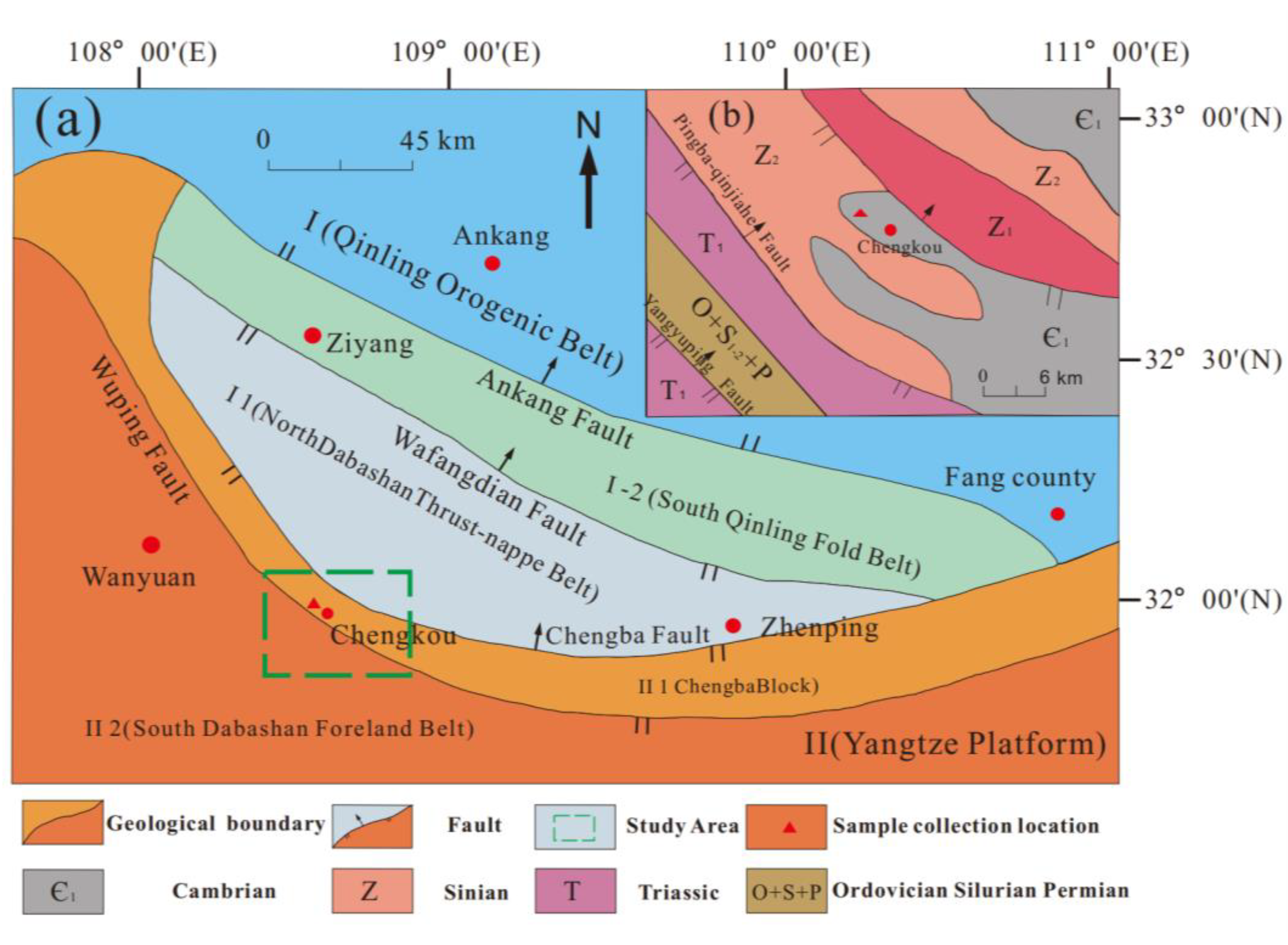

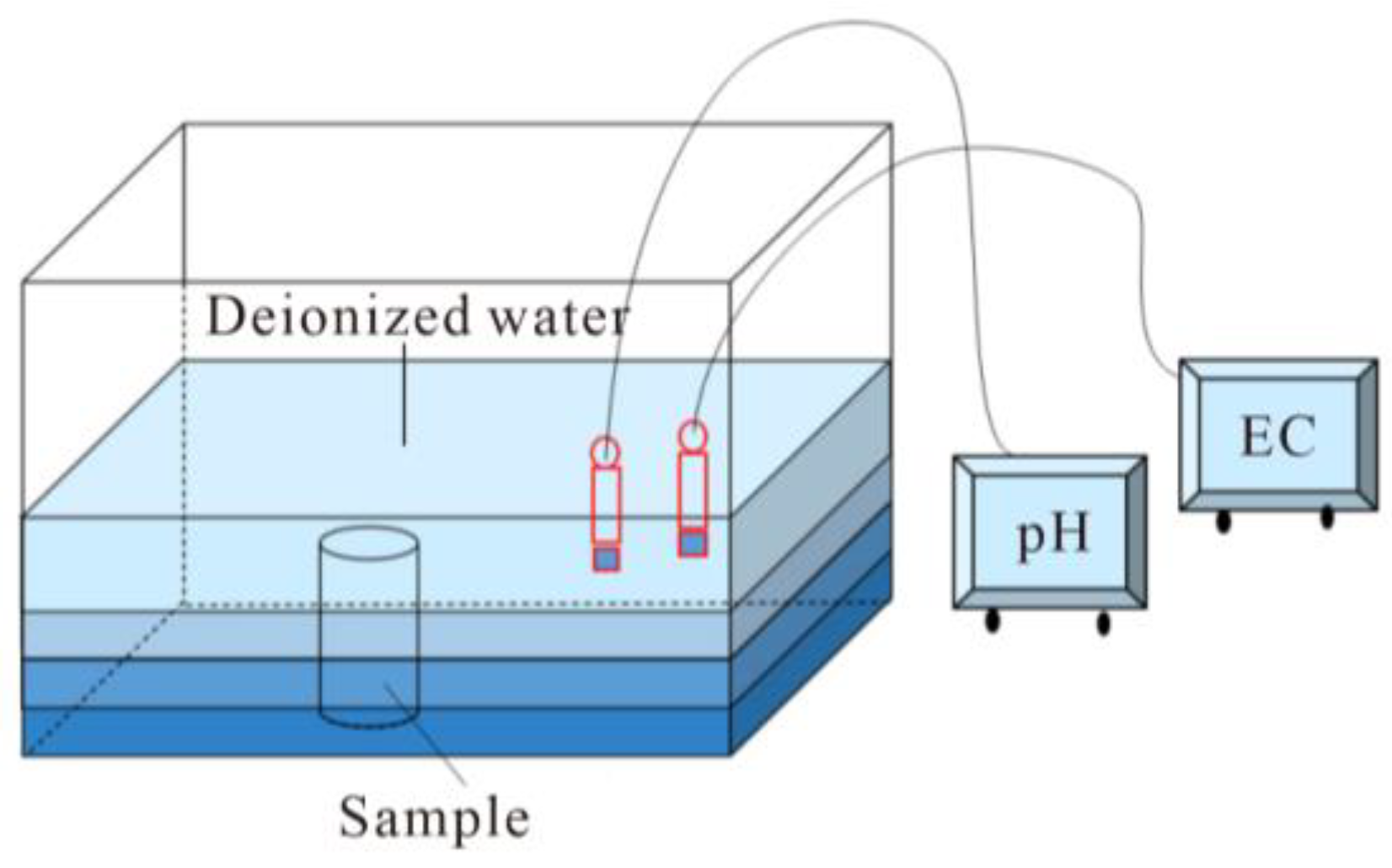
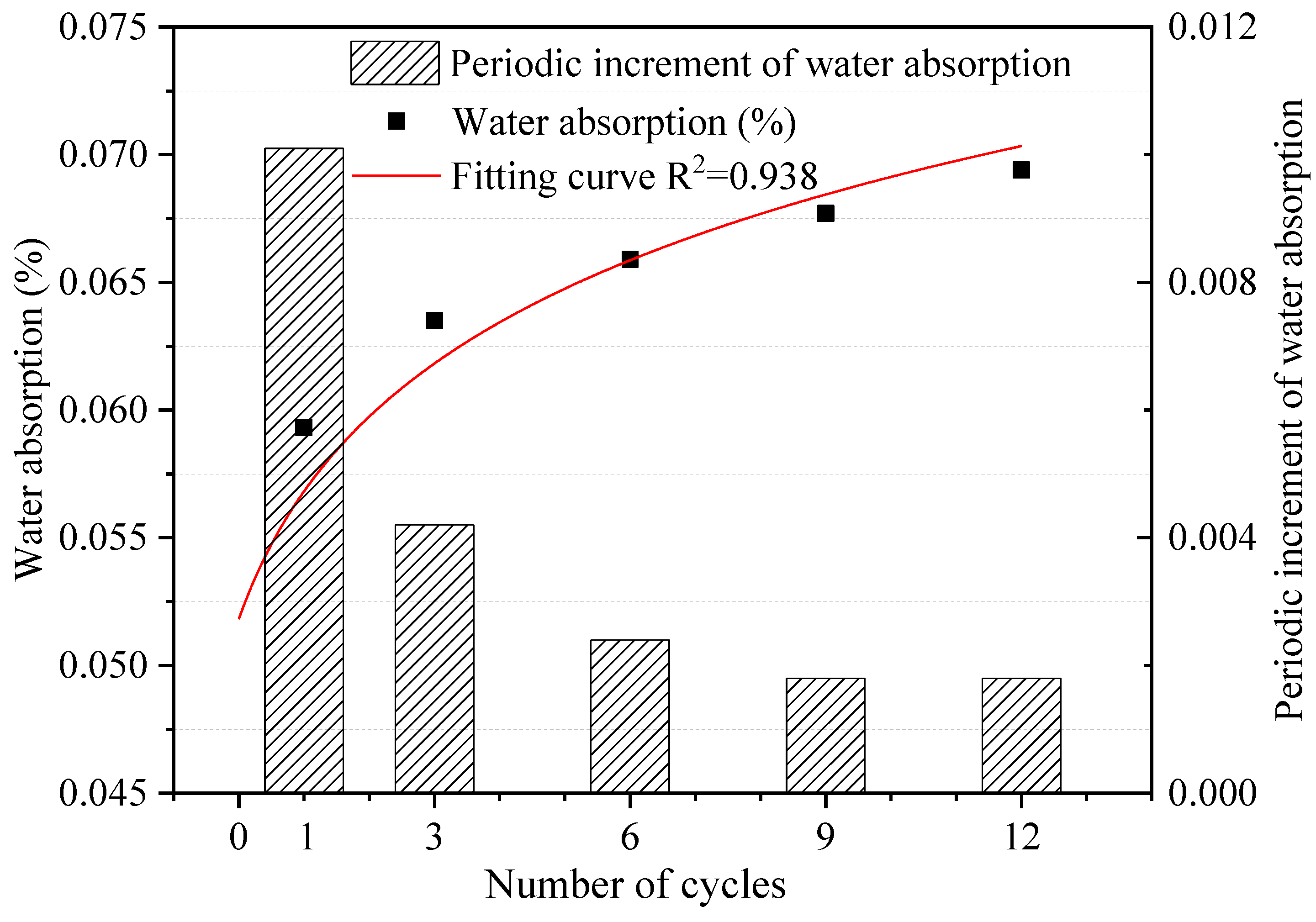

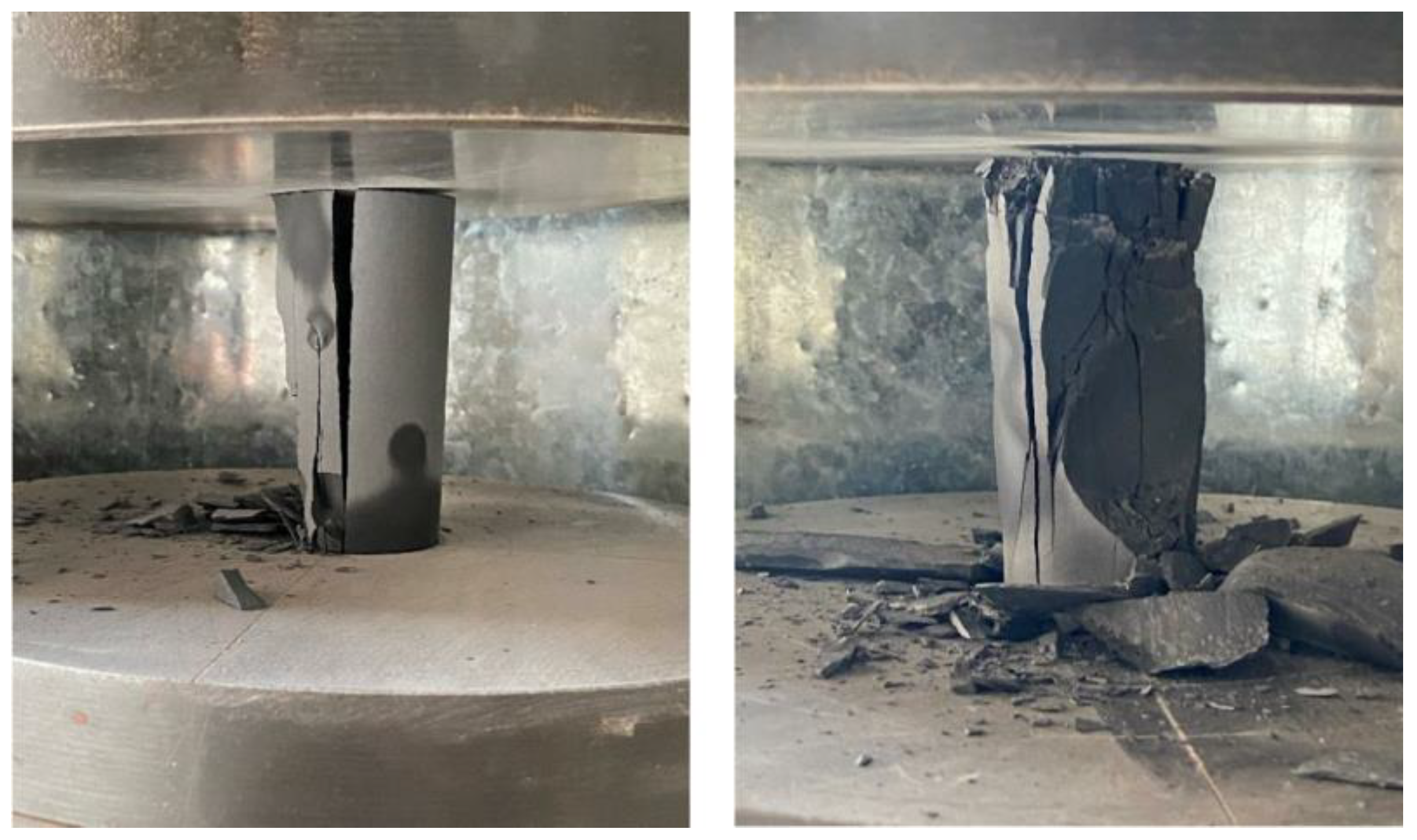
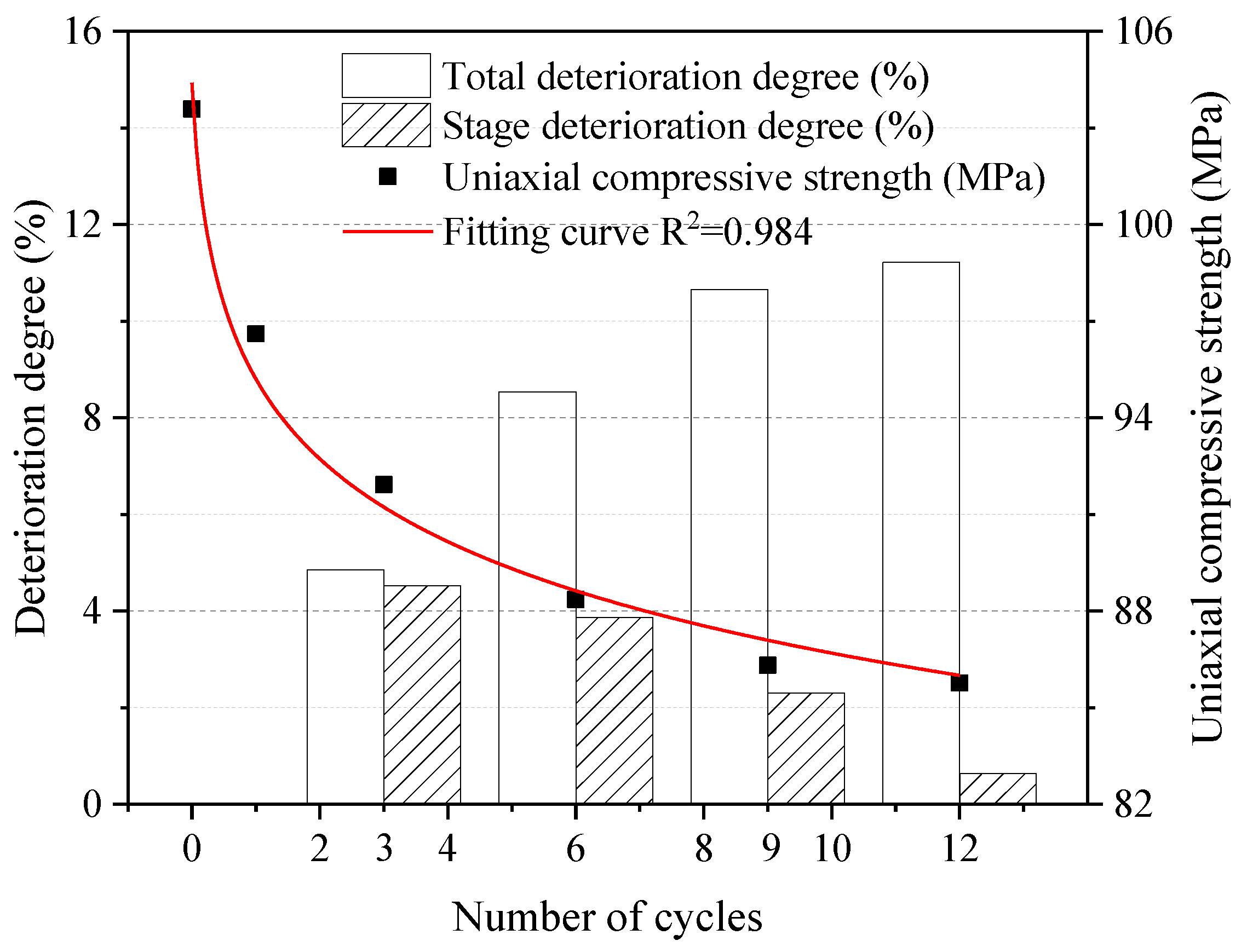
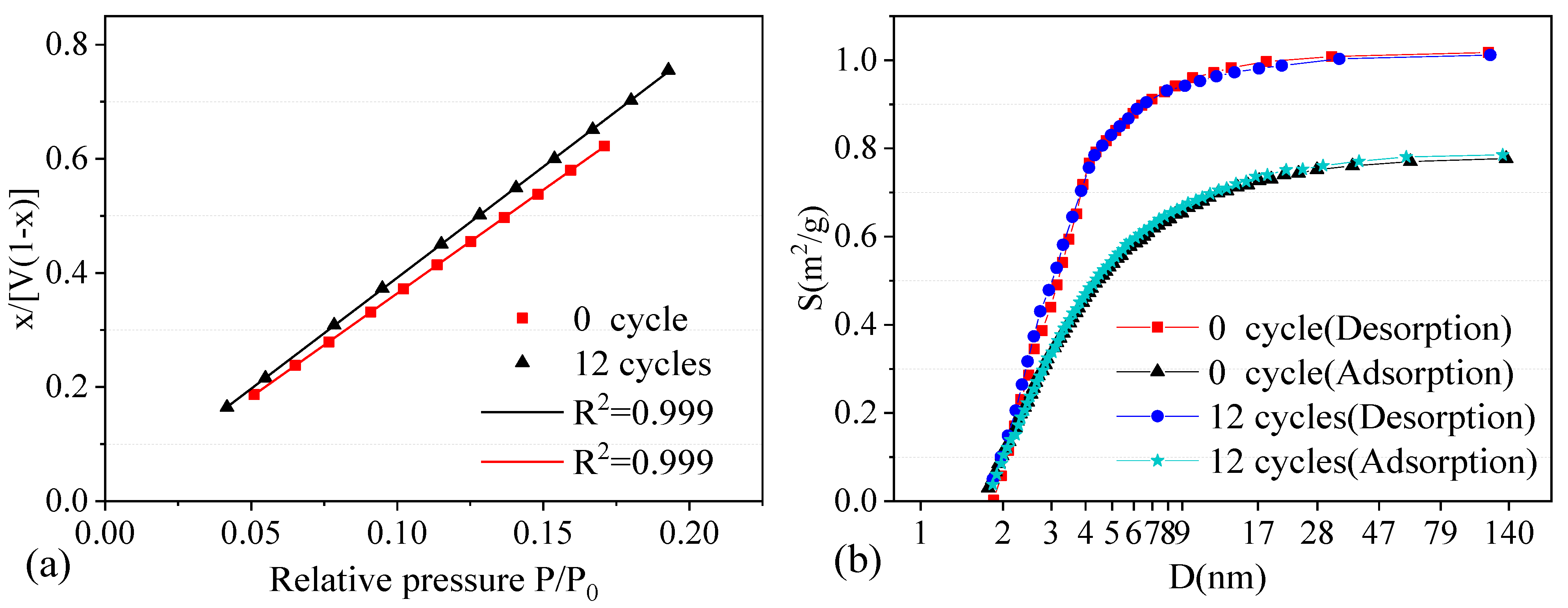
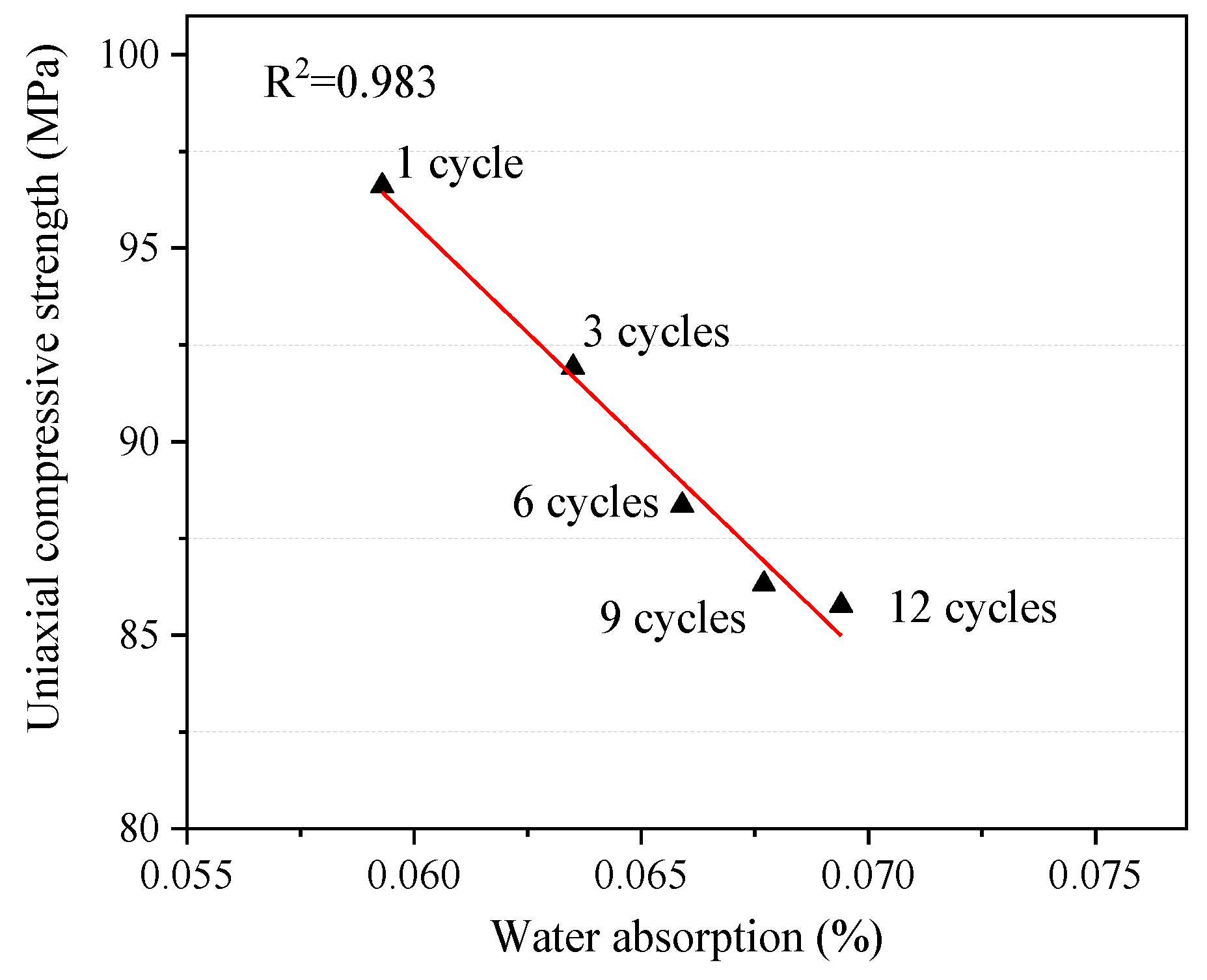

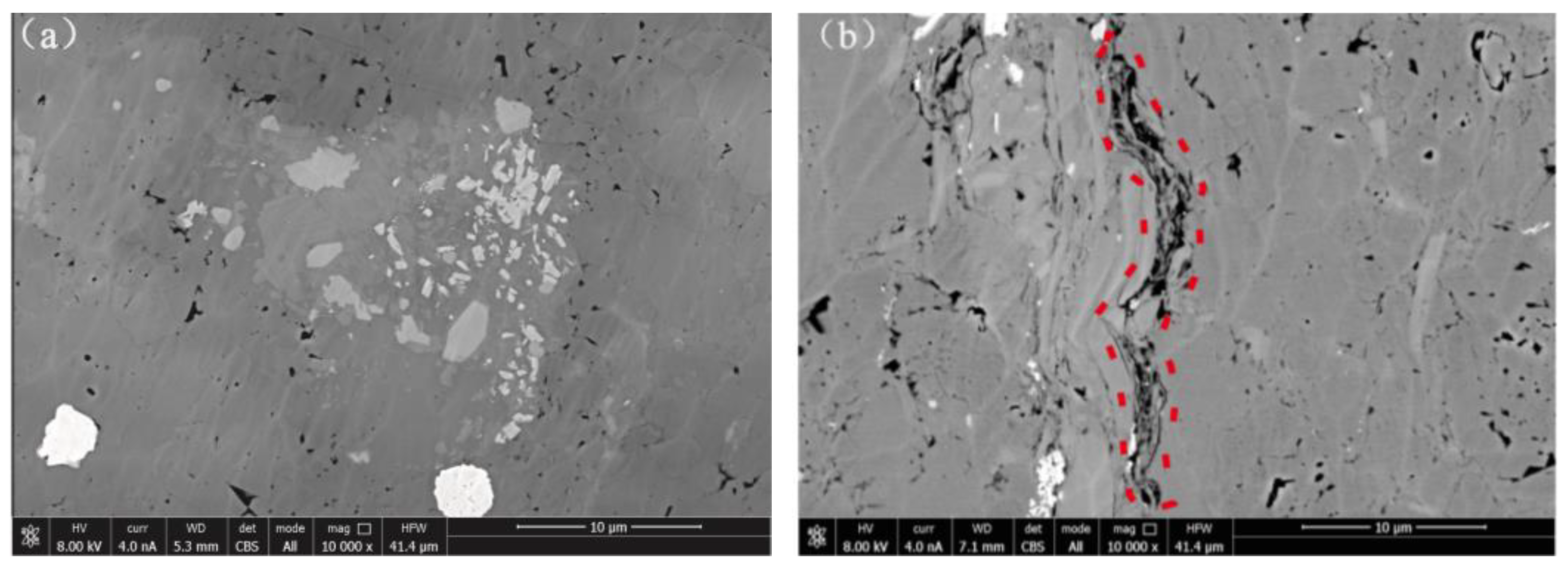
| Specimen | Dolomite | Quartz | Pyrite | Plagioclase | Elysium | Kaolinite | Chlorite |
|---|---|---|---|---|---|---|---|
| K-1 | 52.4 | 31.7 | 4.6 | 2.2 | 1.9 | 0.5 | 0.4 |
| K-2 | 46.6 | 36.8 | 5.3 | 2.9 | 3.1 | 0.3 | 0.6 |
| K-3 | 51.8 | 33.8 | 3.6 | 1.6 | 3.6 | 0.5 | 0.5 |
| Specimen | SiO2 | Al2O3 | TFe2O3 | K2O | MgO | CaO | Na2O | SO3 | TiO2 | P2O5 | LOI |
|---|---|---|---|---|---|---|---|---|---|---|---|
| K-1 | 32.8 | 2.2 | 1.4 | 0.5 | 12.9 | 18.3 | 0.2 | 2.3 | 0.1 | 0.1 | 28.5 |
| K-2 | 36.4 | 3.3 | 1.6 | 0.9 | 11.6 | 16.5 | 0.3 | 2.8 | 0.2 | 0.1 | 25.6 |
| K-3 | 32.0 | 2.2 | 1.3 | 0.6 | 13.0 | 18.6 | 0.2 | 2.3 | 0.1 | 0.1 | 29.0 |
| Number of Cycles | Specific Surface Area (m2/g) | Average Aperture (nm) |
|---|---|---|
| 1 | 1.1987 | 4.6717 |
| 12 | 1.1129 | 5.0319 |
| Cl− | CO32− | HCO3− | SO42− | NO3− | Ca2+ | Mg2+ | K+ | Na+ | Al3+ | TFe | pH |
|---|---|---|---|---|---|---|---|---|---|---|---|
| 0.99 | 42.01 | 61.02 | 1.02 | 1.38 | 4.17 | 1.58 | 0.3 | 0.5 | <0.1 | <0.1 | 7.6 |
Disclaimer/Publisher’s Note: The statements, opinions and data contained in all publications are solely those of the individual author(s) and contributor(s) and not of MDPI and/or the editor(s). MDPI and/or the editor(s) disclaim responsibility for any injury to people or property resulting from any ideas, methods, instructions or products referred to in the content. |
© 2023 by the authors. Licensee MDPI, Basel, Switzerland. This article is an open access article distributed under the terms and conditions of the Creative Commons Attribution (CC BY) license (https://creativecommons.org/licenses/by/4.0/).
Share and Cite
Zhu, L.; Luo, X.; Li, Z.; Li, H.; Liao, X.; Tang, Q. Degradation Characteristics and Mechanism of Black Sandy Dolostone Subjected to Wetting–Drying Cycles. Minerals 2023, 13, 1306. https://doi.org/10.3390/min13101306
Zhu L, Luo X, Li Z, Li H, Liao X, Tang Q. Degradation Characteristics and Mechanism of Black Sandy Dolostone Subjected to Wetting–Drying Cycles. Minerals. 2023; 13(10):1306. https://doi.org/10.3390/min13101306
Chicago/Turabian StyleZhu, Lei, Xinyu Luo, Zhibo Li, Haifeng Li, Xin Liao, and Qiang Tang. 2023. "Degradation Characteristics and Mechanism of Black Sandy Dolostone Subjected to Wetting–Drying Cycles" Minerals 13, no. 10: 1306. https://doi.org/10.3390/min13101306
APA StyleZhu, L., Luo, X., Li, Z., Li, H., Liao, X., & Tang, Q. (2023). Degradation Characteristics and Mechanism of Black Sandy Dolostone Subjected to Wetting–Drying Cycles. Minerals, 13(10), 1306. https://doi.org/10.3390/min13101306






